What is Carnival Glass?
Basic Information ~ History & Overview
“Carnival glass” is pressed or blown glass, produced in a myriad of colors, patterns and shapes, having a characteristic iridescent, multicolored rainbow-like “oil slick on mud puddle” appearance to the surface, first produced circa 1908.
Carnival glass was originally produced as a cheaper alternative to expensive blown iridescent glass such as that made by Tiffany & Company of New York.
Many kinds of glass articles, both ornamental as well as utilitarian, were made with the “carnival” finish, and patterns ranged from simple through geometric and “cut glass” styles to pictorial and figurative. A wide range of colors and color combinations were used but the most common colors accounted for a large proportion of output, so scarce colors can today command very high prices on the collector market.
Carnival glass gets its iridescent sheen from metallic salts that were sprayed on the surface of the glass while it was still very hot. A final firing of the glass brings out the iridescent, shimmery look caused by the presence of the salts, giving carnival glass the distinct appearance it’s known for.
Its current name was adopted by collectors (probably in the 1950s) from the fact that it was sometimes given away as prizes at carnivals or fairs. However, most Carnival glass was not distributed in that way, but likely the greater part was purchased from retail outlets, including general stores, variety stores, department stores and “dime stores”. The glass was also given away as premiums to encourage the purchase of various products.
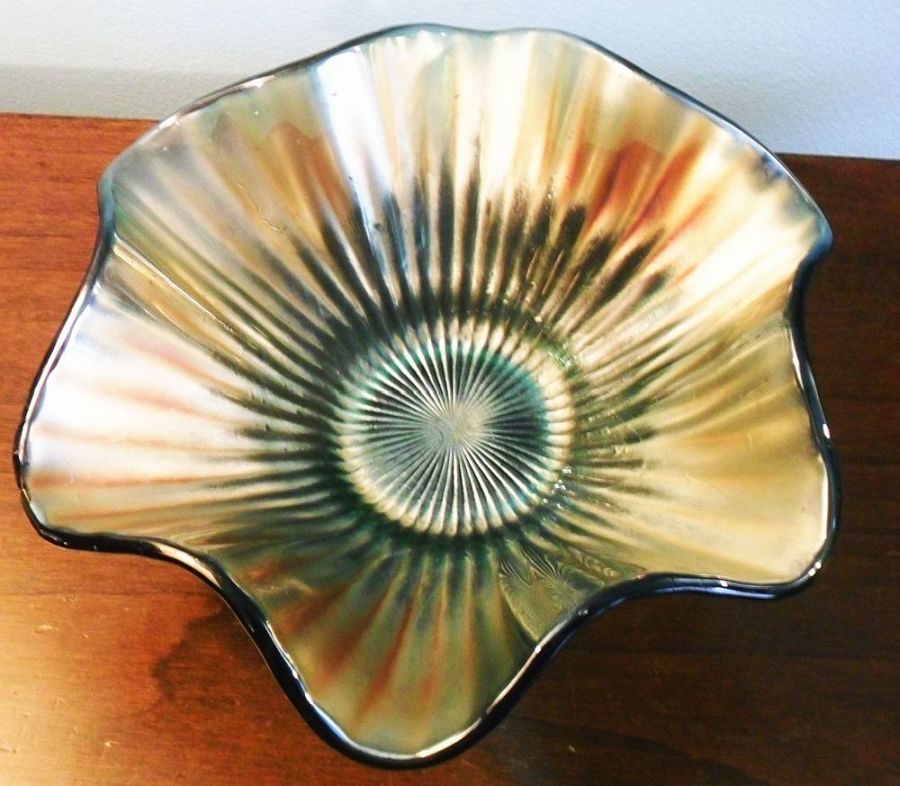
Some carnival glass is still produced today although in much less quantity than during it’s heyday of production. At the height of its popularity in the 1920s, tremendous quantities of glassware was produced and prices were low enough for the average, middle class household to afford.
The majority of this type of glass was produced in the United States, although it also became fairly popular in Europe, with a number of glass companies making iridescent glass there as well. Nearly all the major European glass-making centers produced some carnival glass. It was also very popular in Australia.
ORIGIN
Carnival glass originated as a glass called Iridill, produced beginning in 1908 by the Fenton Art Glass Company (1905-2011). Iridill was inspired by the fine blown art glass of such makers as Tiffany and Steuben, but did not sell at the anticipated premium prices and was subsequently discounted. After these markdowns, Iridill pieces were used as carnival prizes. Iridill became popular and very profitable for Fenton, which produced many different types of items in this finish, in over 150 patterns. Fenton maintained their position as the largest manufacturer and were one of very few makers to use a red colored glass base for their carnival glass.
ADVERTISEMENT
After interest declined in the late 1920s, Fenton stopped producing carnival glass for many years. In more recent years, due to a resurgence in interest, Fenton restarted production of carnival ware and continued making it until about 2007.
Most U.S. carnival glass was made before the mid-1920s, with production rapidly declining thereafter. Some significant production continued outside the US through the depression years of the early 1930s, tapering off to very little by the 1940s.
Often the same molds were used to produce clear and transparent colored glass as well as carnival versions, so producers could switch production between these finishes easily according to the current demand / popularity.
Iridescent glassware was made in a wide array of colors, shades, color combinations and variants. More than fifty have been formally classified. These classifications do not go by the “apparent” surface colors, which can be even more varied, but by the “base” (actual) colors of the glass itself, before application of the iridizing mineral salts.
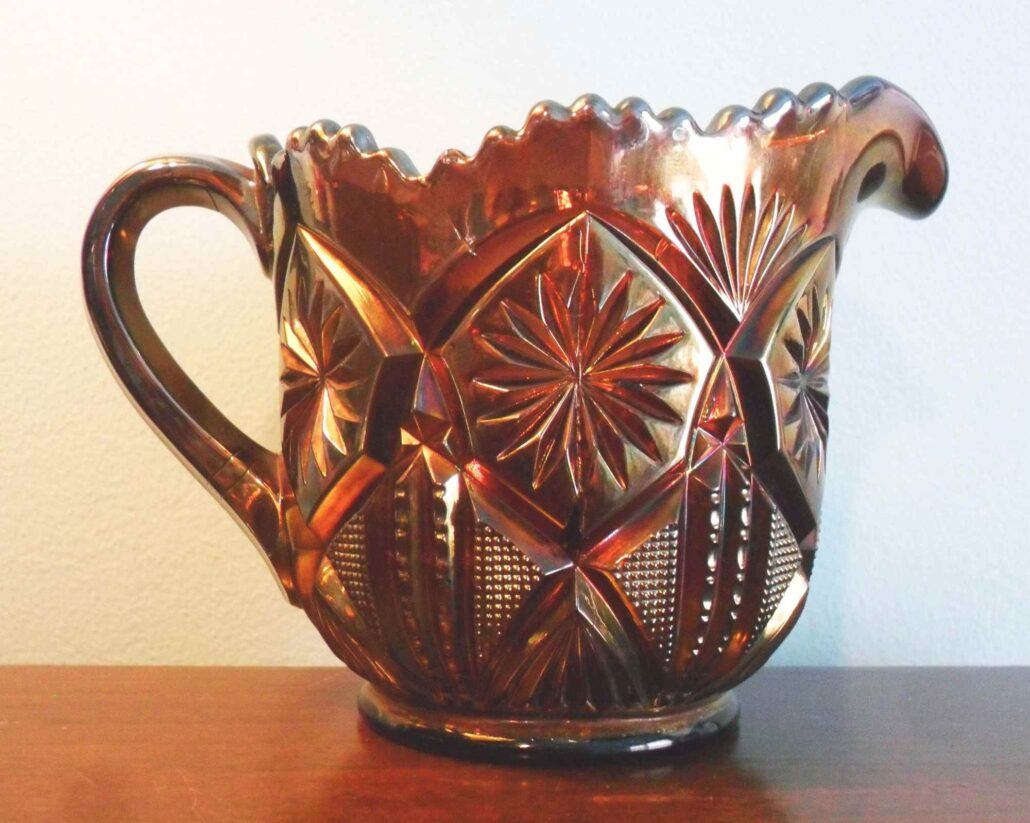
In order to ascertain the actual base color, you have to find an area of the item which had no mineral salts applied, which is usually the base, and hold the item up to the light in such a way that you can see through that area.
This is usually easy enough to do, but it can still be difficult for the inexperienced to differentiate the exact base color between the many possibilities as there are often only subtle differences, as well as variations.
COLORS
The most common (most abundantly made) color for iridescent glass is now known by collectors as “Marigold” although that name was not in use at the time it was first produced. Marigold has a clear glass base and is the most easily recognizable carnival color.
The surface colors of marigold are generally a bright orange, yellow, and/or gold, turning sometimes to a rich copper with areas showing accentuated rainbow or ‘oil-slick’ highlights. The highlights may appear mostly on ridges in a pattern, and vary in appearance according to the strength and angle of nearby lighting.
However, variants of marigold such as those based on ‘moonstone’ a translucent white and milk glass, an opaque white base, can be more sought after. Other base colors include amethyst (a reddish purple), blue, green, red and amber (brown). These basic colors are then further delineated by shade, depth of color, color combinations such as “amberina” (yellowish or yellow-amber shading to a deep orange or red), color patterns such as “slag”, and special treatments such as opalescent.
ADVERTISEMENT
SHAPES
The basic items produced in carnival glass included bowls, plates, vases, jugs, pitchers, creamers and tumblers but many other more specialized items of tableware have also been made. These included large center piece items such as jardinières and float bowls, as well as smaller useful items such as butter dishes, celery vases and cruet sets.
In smaller numbers (and seen much less often) are items having to do with lighting, or associated with smoking and those designed solely for show as ornaments, such as figural sculptures or statuettes.
Companies that produced Carnival Glass
Carnival glass was produced in large quantities in the US, besides the aforementioned Fenton Art Glass Company, by Indiana Glass Company, Northwood Glass Company, as well as Imperial, Millersburg, Westmoreland, Dugan/Diamond, Cambridge, and U.S. Glass companies, plus a number of smaller or lesser-known glass manufacturers. At least 20 different glass companies located within the United States made this type of glass at some time in their history.
Competition became so fierce that new patterns were continually being developed, so each company ended up making a range of patterns to give the customer a wider variety of choices.
Different and in many cases highly distinctive carnival patterns were designed by non-US makers, most notably by Crown Crystal of Australia, known for their depiction of that continent’s distinctive fauna and flora in their glass. Sowerby (England) is notable for their use of swan, hen and dolphin figural pieces in an iridescent finish as well as pieces which have figural parts such as bird figured legs.
German production of carnival was dominated by the Brockwitz glassworks, with mainly geometric patterns which take their cues from cut glass. Other major European producers included Inwald (Czechoslovakia), Eda (Sweden) and Riihimäki (Finland).
During the early 1970s carnival glass again became quite popular and several glass companies in the US starting producing it again to satisfy demand from the general public. These would include Indiana Glass, Imperial, Fenton, Westmoreland and others. Mosser Glass Company of Cambridge, Ohio has produced the “new” or “revival” Carnival glass since the early 1970s sporadically up to the present day.
Marks / Markings on Carnival Glass
A fairly large percentage of Carnival glass is not marked to indicate the glassmaker, so it can be problematic to discover the company that produced a particular piece. Nevertheless, quite a few glass companies did mark some of their glass, at least some percentage of their glass output. This would include Imperial, Westmoreland, Northwood, L. E. Smith, Fenton, Boyd, Mosser, Summit and others. Here is a very informational webpage (by researcher David Doty) with photographs of actual markings seen on Carnival Glass ware: https://www.ddoty.com/makermarks.html
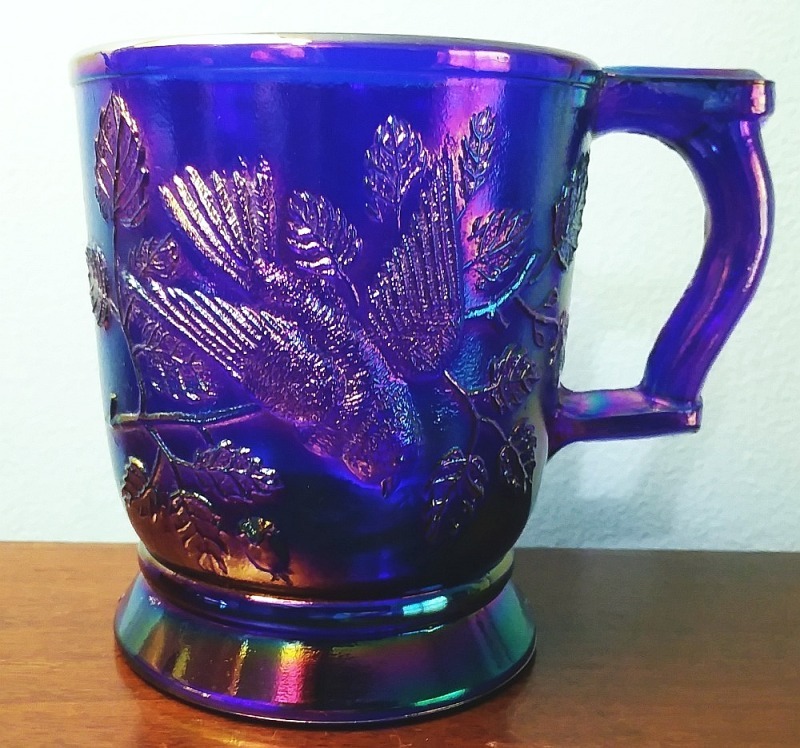
Most carnival glass is considered to be highly collectible. Prices do vary widely, with some pieces (such as certain pieces made in large quantities in a more common color) being worth relatively little, but other very rare items commanding thousands of dollars on the open market. Examples of this type of glass are seen frequently in most antique stores, and there is an active market for it on the ebay.com auction website and other online venues.
Identification of carnival glass is frequently VERY difficult. Many manufacturers did not include a glass maker’s mark on their product, and some did so only for part of the time they were producing the glass. Identifying the glass often involves matching patterns, colors, sheen, edges, thickness, and other factors from old manufacturer’s trade catalogs, other known examples, or other reference material. There are several very informative websites on the internet that list patterns and makers of iridescent Glass (see links below).
Many of the glass manufacturers who produced this glass copied patterns (with or without slight changes) from their competitors, so it is often very difficult to know for sure where, or by whom, a particular piece was made.
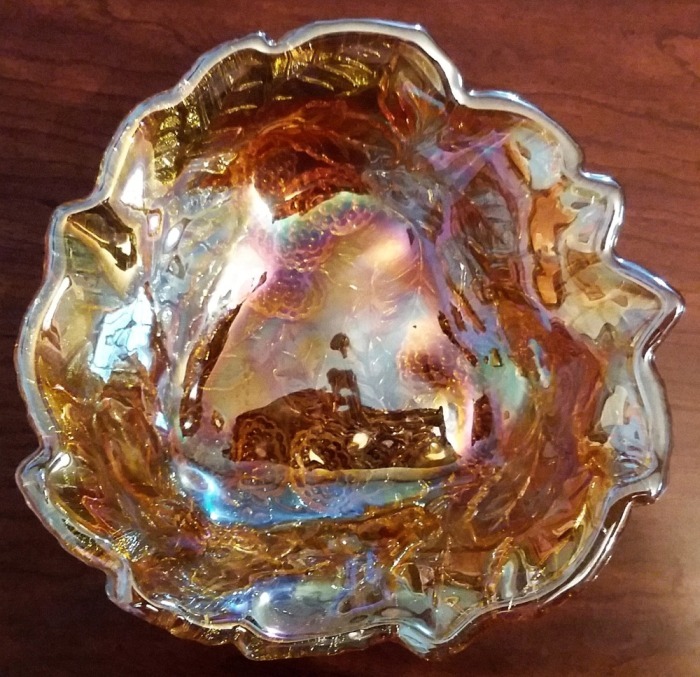
Indiana Glass Company
Indiana Glass Company, Dunkirk, Indiana, produced a lot of the “New” iridescent glass, starting in the early and mid-1970s, including many patterns and pieces in blue, amber, green and marigold. It is very commonly seen in flea markets and antique stores. (Virtually none of the glassware made by Indiana was marked with a permanent trademark, signature or marking of any kind).
Many types of dishes, bowls, compotes, vases, etc, were made in carnival. Their characteristic “Hen on Nest” dish was made in several shades of iridescent glass. (Please see my Indiana Glass “Hen on Nest” webpage with more info on that particular type of hen).
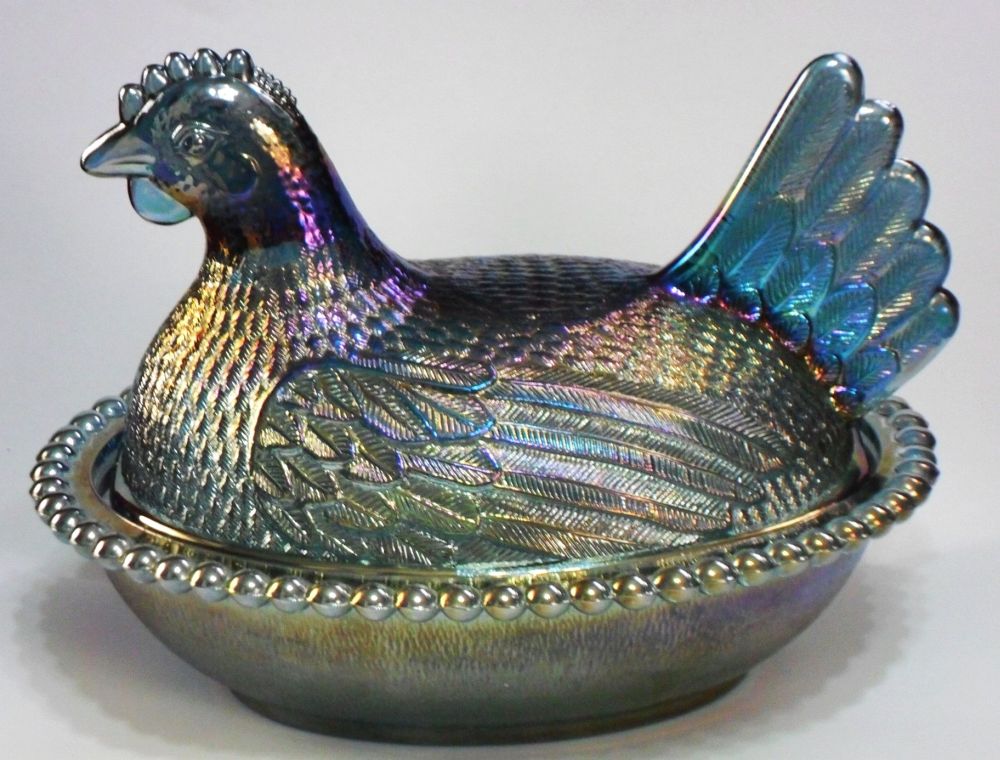
Carnival Glass Insulators
Glass electrical power line insulators are also found in Carnival glass, although the intent of production was not ornamental. The application of metallic salts to the surface of power line insulators was practiced in an effort to increase the effectiveness of the insulating properties of the product (i.e., reducing loss/leakage of the electric current to the surrounding environment).
Most carnival insulators, made by Corning Glass Works (makers of the Pyrex brand insulators) and Hemingray Glass Company, typically date from the 1920s and 1930s. They are avidly collected by both carnival glass buffs as well as glass electrical insulator collectors.
For a comprehensive site all about carnival glass, with TONS of great information, check out this website by collector/author/researcher David Doty: David Doty’s Carnival Glass Website
Another great website with gobs of superb information on carnival glass: Hooked on Carnival
Here’s an ebay search on Carnival Glass: Carnival Glass keyword search on eBay
For an extensive list of glass manufacturers’ marks on bottles, fruit jars, electrical insulators, tableware and other glass items, please click here to go to the Glass Bottle Marks, Page One
Please click here to go to my website Home Page.
Check out my webpage on the “Robin in Tree” child’s mug made by both Bryce Brothers and Mosser Glass Company. (Mosser made a number of different colors of these mugs including iridescent/Carnival glass).
Some other webpages on this site about different categories of glass:
Early American Pattern Glass (EAPG)
ADVERTISEMENT


There is a website that is devoted to helping carnival glass collectors learn more about this beautiful glass. They have a daily mail list and a pricing database with pictures of the piece that sold. The best part is it’s all free. http://www.hookedoncarnival.com
Hi Galen,
I checked out the site and I am truly impressed. It’s a wonderful site with tons of great information and gobs of superb pictures! It would be a very good place for anyone interested in carnival glass to do some extended browsing! Thanks for the link, and I’m happy to pass this information along to readers. Take care,
David
Can you help me research the history and genealogy of WILLIAMS family name on soda bottles that say property of Coca Cola— and all WILLIAMS connections in the glass industry! Lewis A Williams in particular?!
Hi Pat,
I’m sorry but I can’t. Don’t have the time or resources. However, I am posting your comment here, in case someone should happen to land on this site who would be willing to help with your research.
best regards,
David
I found this bottle a few yrs ago,and haven’t been able to find out how old it it,so I thought you might be able to help me. The bottle is pink,and it has a raised pattern on it which look like a sunshine,and it has a number on the bottom REGOH2755481 Thank you for your time and help. Susan Sisneros
Susan,
I don’t know about your bottle.
You might try google searches with spaced variations of the markings you see, such as “REGO H2755481” .
Best regards,
David
Update on this thread: The correct embossing is “REGD No 755481” and this is marked on the bottom of a British-manufactured cosmetic powder jar. The design number (design patent) was registered in 1930. (Although specimens with this marking may have been made for years afterward). The bottle has been seen in a pale pinkish glass, light green, and perhaps other colors.